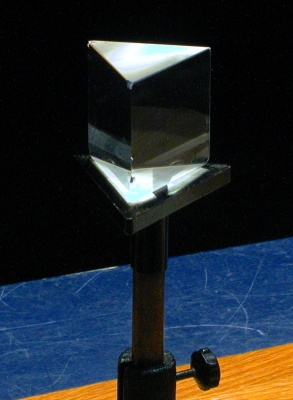What it shows:
Light is refracted as it passes between two transparent materials of different refractive indices. If the materials are different, but the refractive indices are not, then the light rays are undeviated and the materials are optically indistinguishable.
How it works:
"And if you put a sheet of common white glass in water, still more if you put it in some denser liquid than water, it will vanish almost all together, because the light passing from water to glass is only slightly refracted or reflected or indeed affected in any way."
— H. G. Wells, The Invisible Man
A glycerin/water solution is prepared (see setting it up) with the same refractive index as quartz (n=1.46). Into a beaker of this solution is placed a quartz prism. The refractive indices being identical means that there is no refraction at the glycerin/quartz boundary and light rays pass through the beaker undeviated. The prism is invisible. The effect is particularly noticeable on the prism face where total internal reflection has occurred while the prism is in air. To avoid sticky fingers, the prism is attached to a glass rod with epoxy resin; this adds to the demo, as the glass rod, with its different refractive index, is still visible in the glycerin.
Setting it up:
The refractive index of glycerin can be altered by diluting it with water. The use of a beaker of pure water as well as the glycerin/water mixture will emphasize the requirement of identical refractive index.
Comments:
The prism's disappearance is not complete, as the sharp vertices of the prism are still visible as pencil lines.

Reference:
H. G. Wells (1892) The Invisible Man, Bantam Books, 1988